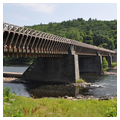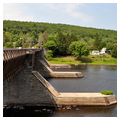The Delaware Aqueduct was a refinement of the Delaware and Hudson Canal of a generation earlier. That canal had provided a oneway navigation (like Josiah White's on the upper Lehigh River in Stoddartsville; see MN11) for barges to carry anthracite from the Lackawanna coal district at Honesdale in Wayne County to New York City. Canal boats crossed the Delaware in a slackwater created by a dam that disrupted the downriver course of lumber and other products. By the 1840s despite multiple enlargements, the canal had reached the limits of its expansion because of the difficulty of crossing the Delaware River and the simultaneous interference with the downriver traffic. Roebling solved the problem with a water-filled canal carried on massive stone piers joined by suspension cables carrying the waterway and a towpath alongside. When the canal was finally abandoned in 1898, the aqueduct was converted to a private toll bridge.
In 1980 it was acquired by the National Park Service as a part of the Upper Delaware Scenic and Recreational River. Remarkably the original 8.5-inch-diameter cables, composed of 2,150 wires bunched in seven strands, wirewound for protection, and spun on-site under Roebling's direction, are still viable and carry the bridge across the river. The decking was restored by the National Park Service in 1986 and the wood icebreakers and towpaths were reconstructed in 1995. Pedestrians can now cross what was once a watery highway above the Delaware.




















